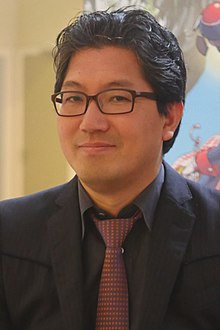Portal:Video games
The Video Games Portal

A video game, also known as a computer game or just a game, is an electronic game that involves interaction with a user interface or input device (such as a joystick, controller, keyboard, or motion sensing device) to generate visual feedback from a display device, most commonly shown in a video format on a television set, computer monitor, flat-panel display or touchscreen on handheld devices, or a virtual reality headset. Most modern video games are audiovisual, with audio complement delivered through speakers or headphones, and sometimes also with other types of sensory feedback (e.g., haptic technology that provides tactile sensations). Some video games also allow microphone and webcam inputs for in-game chatting and livestreaming.
Video games are typically categorized according to their hardware platform, which traditionally includes arcade video games, console games, and computer (PC) games; the latter also encompasses LAN games, online games, and browser games. More recently, the video game industry has expanded onto mobile gaming through mobile devices (such as smartphones and tablet computers), virtual and augmented reality systems, and remote cloud gaming. Video games are also classified into a wide range of genres based on their style of gameplay and target audience. (Full article...)
Featured articles –
Cawthon conceived the idea for Five Nights at Freddy's based on criticism of his previous game, Chipper & Sons Lumber Co. Reviewers complained of its unintentionally frightening characters that had animatronic-like movement, inspiring Cawthon to create an intentionally scarier experience. Developed in six months using the Clickteam Fusion 2.5 game engine, Five Nights at Freddy's was released for Windows through Desura on August 8, 2014, and through Steam on August 18. It was made available for Android, iOS, and Windows Phone later in 2014. Versions for Nintendo Switch, PlayStation 4, and Xbox One were released in 2019.
Five Nights at Freddy's received generally positive reviews from critics, many considering it a frightening and unique horror game. Reviewers praised the atmosphere, sound design, and gameplay mechanics, although some found the jumpscares repetitive and the game to have little replay value. It became the subject of Let's Play videos on YouTube and gained a large fan following. The game's success led to the launch of a media franchise, including many sequels and books, and its popularity led to several imitations and fangames. Its successor and chronological prequel, Five Nights at Freddy's 2, was released on November 10 of the same year. A film adaptation by Blumhouse Productions was released in 2023. (Full article...)
The gameplay is similar to previous installments, focusing on combo-based combat with the player's main weapon—the Blades of Exile—and secondary weapons acquired during the game. It uses quick time events, where the player acts in a timed sequence to defeat strong enemies and bosses. The player can use up to four magical attacks and a power-enhancing ability as alternative combat options, and the game features puzzles and platforming elements. Compared with previous installments, God of War III offers a revamped magic system, more enemies, new camera angles, and downloadable content.
God of War III was critically acclaimed upon release, with praise for the graphics, gameplay, and scope, although the plot received a mixed response. The game received several awards, including "Most Anticipated Game of 2010" and "Best PS3 Game" at the 2009 and 2010 Spike Video Game Awards, respectively, and the "Artistic Achievement" award at the 2011 British Academy of Film and Television Arts (BAFTA) Video Game Awards. The second best-selling game in the God of War series and the ninth best-selling PlayStation 3 game of all time, it sold nearly 5.2 million copies worldwide by June 2012 and was included in the God of War Saga released for PlayStation 3 on August 28, 2012. Since its release, it has also been named as one of the greatest video games ever made. In celebration of the God of War franchise's tenth anniversary, a remastered version of the game, titled God of War III Remastered, was released for the PlayStation 4 (PS4) on July 14, 2015; as of June 2023, the remastered version has sold an estimated 4 million copies. After two more prequels were released, a direct sequel to God of War III simply titled God of War was released on April 20, 2018, which served as a soft-reboot of the franchise and shifted the setting to Norse mythology. (Full article...)
Gameplay is presented from the third-person perspective and game objectives are divided into four categories: search and destroy, reconnaissance, rescue, and protect. The player can control five craft and each offers a unique armament arrangement, as well as varying degrees of speed and maneuverability. Bonus power-ups that improve these crafts' weapons or durability are hidden in different levels throughout the game. The player's performance is checked against three medal benchmarks after the completion of each level. Acquiring these medals promotes the player's rank and helps unlock hidden content.
Rogue Squadron's focus on flight combat was directly inspired by a level in Star Wars: Shadows of the Empire that allowed the player to pilot a snowspeeder. Working together during development, Factor 5 designed the game engine, the music, and worked closely with Nintendo, while LucasArts produced the game's story and gameplay and ensured it was faithful to Star Wars canon. Before the game's release, Factor 5 successfully appealed to Nintendo to release the Nintendo 64's newly developed memory Expansion Pak commercially. Consequently, Rogue Squadron was one of the first games to take advantage of the Expansion Pak, which allows gameplay at a higher display resolution. (Full article...)
Corruption is set six months after the events of Metroid Prime 2: Echoes (2004). It follows the bounty hunter Samus Aran, who becomes infected with Phazon by her doppelgänger Dark Samus. Samus works to prevent the Phazon from spreading to other planets while being corrupted by the Phazon.
The player controls Samus using the Wii Remote and Nunchuk devices. The remote is used for jumping, aiming, and firing weapons, while the Nunchuk enables actions such as moving Samus and locking onto enemies. Corruption introduces features such as Hypermode, which allows Samus to use more powerful attacks, and the ability to command her gunship. The new control scheme took a year to develop and delayed the game's release several times. The game was first shown to the public at the E3 2005 trade show. (Full article...)
Tetsuya Nomura designed Tidus with a cheerful appearance that contrasts with previous Final Fantasy protagonists. Scenario writer Kazushige Nojima wanted to expand the relationship between player and character with monologues that describe the game's setting. The narrative was initially focused on the romance between Tidus and Yuna, but Square Enix decided the main focus would be on Tidus's relationship with Jecht to provide a major impact in the setting. Tidus is voiced primarily by Masakazu Morita in Japanese and James Arnold Taylor in English; both actors enjoyed voicing the character, and Morita also performed his motion capture.
Tidus has been generally well-received by video-game critics. Tidus' cheerful personality and heroism make him an appealing protagonist, contrasting with previous male characters in the franchise and being comparable to messiah figures and other fictional heroes. Tidus's character development and romantic relationship with Yuna are considered among the best in video games, although reviewers and fans were divided on Taylor's voicing. Tidus has been popular with fans, often ranking in polls as one of the best Final Fantasy characters. Action figures and Tidus-related jewelry have been produced, and he is a popular character among cosplayers. (Full article...)
Did you know... -
- ... that a version of the video game Rhino Rumble was not released due to the creators not wanting to add licensed characters?
- ... that deceased YouTuber Technoblade beat the video game Minecraft in hardcore mode using a racing-wheel controller?
- ... that the case Lewis Galoob Toys, Inc. v. Nintendo of America, Inc. was considered essential to the future of video game modding in the United States in 1992?
- ... that the urban legend Herobrine was ranked on a Guinness World Records poll of the best video game villains, despite never existing?
- ... that Kainé from the video game series Nier was created in response to a female staff member's vague wish for a "male heroine"?
- ... that the 1987 video game Oriental Hero was panned as "so incredibly bad it's almost worth a look"?
- ... that the Chicago Sun-Times credits JumpStart Toddlers as the first video game targeted towards babies?
- ... that development on the video game Expeditions: Rome was not affected by lockdowns from the COVID-19 pandemic because the developer was already split between Copenhagen and Istanbul?
- ... that a cheat code for the 2003 video game Hulk is hidden in a scene of the film it is based on?
- ... that classified documents of the United States were partially leaked onto a Discord server for the video game Minecraft?
- ... that the concept of adding strippers to the extreme sports video game BMX XXX was initially proposed in jest?
- ... that the video game Pyongyang Racer was developed in North Korea for Koryo Tours, which organises tours to the country?
Selected biography –
Selected image -
Recent video game-related events
- September 12, 2024 – 2023–2024 video game industry layoffs
- Microsoft announces that it will lay off 650 Microsoft Gaming employees as part of cuts to its workforce. (Variety)
- August 15, 2024 –
- American video game magazine Game Informer discontinues publication after 33 years. The magazine's website is also shut down. (BBC News)
- May 24, 2024 – Uvalde school shooting
- Families in Uvalde, Texas, U.S., file a lawsuit against Daniel Defense and Activision Blizzard for creating the DDM4 V7 gun and promoting the weapon through the game Call of Duty, respectively. They also sue Meta Platforms for owning Instagram, which was used by the gunman. (AP)
Topics
Categories
Things you can do
In other Wikimedia projects
The following Wikimedia Foundation sister projects provide more on this subject:
-
Commons
Free media repository -
Wikibooks
Free textbooks and manuals -
Wikidata
Free knowledge base -
Wikinews
Free-content news -
Wikiquote
Collection of quotations -
Wikisource
Free-content library -
Wikiversity
Free learning tools -
Wiktionary
Dictionary and thesaurus














































